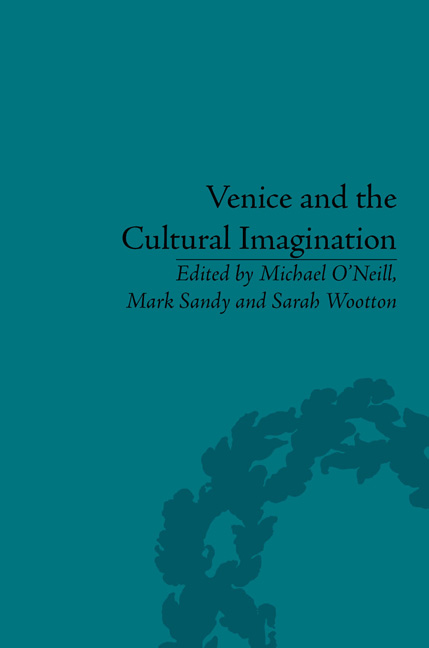Book contents
- Frontmatter
- CONTENTS
- Acknowledgements
- List of Figures
- Notes on Contributors
- Introduction
- 1 A ‘More Beloved Existence’: From Shakespeare's ‘Venice’ to Byron's Venice
- 2 Reimagining Venice and Visions of Decay in Wordsworth, the Shelleys and Thomas Mann
- 3 J. M. W. Turner and the ‘Floating City’
- 4 Venice and Opera: Tradition, Propaganda and Transformation
- 5 Venice, Dickens, Robert Browning and the Victorian Imagination
- 6 ‘The Lamp of Memory’: Ruskin and Venice
- 7 Edith Wharton's ‘Venetian Backgrounds’
- 8 Henry James's Venice and the Visual Arts
- 9 The Myth of Venice in the Decline of Eliot and Pound
- 10 Representations of Venice in Daphne du Maurier's Don't Look Now and Nicolas Roeg's Screen Adaptation
- Notes
- Select Bibliography
- Index
1 - A ‘More Beloved Existence’: From Shakespeare's ‘Venice’ to Byron's Venice
- Frontmatter
- CONTENTS
- Acknowledgements
- List of Figures
- Notes on Contributors
- Introduction
- 1 A ‘More Beloved Existence’: From Shakespeare's ‘Venice’ to Byron's Venice
- 2 Reimagining Venice and Visions of Decay in Wordsworth, the Shelleys and Thomas Mann
- 3 J. M. W. Turner and the ‘Floating City’
- 4 Venice and Opera: Tradition, Propaganda and Transformation
- 5 Venice, Dickens, Robert Browning and the Victorian Imagination
- 6 ‘The Lamp of Memory’: Ruskin and Venice
- 7 Edith Wharton's ‘Venetian Backgrounds’
- 8 Henry James's Venice and the Visual Arts
- 9 The Myth of Venice in the Decline of Eliot and Pound
- 10 Representations of Venice in Daphne du Maurier's Don't Look Now and Nicolas Roeg's Screen Adaptation
- Notes
- Select Bibliography
- Index
Summary
This volume examines the representation of Venice in painting, music and literature since 1800. Byron is rightly placed first in such a volume for he was the harbinger of the cult of Venice as a place of enchantment which naturally belongs to the world of art rather than as an actual polis which belongs to history. But Byron always confounds as well as establishes distinctions; he looks backwards as well as forwards as I will do in this essay. Moreover, Byron engaged with the ‘the far times’ of the thousand-year polis and the recent arrival of Austrian police as much as he did with Venice as some ‘strange dream upon the water’. Yet he is always conscious that he is refashioning previous representations of the city.
Andrea di Robilant argued that ‘Byron gave the city a new life by turning those sinking ruins into an existential landscape – an island of the soul’. Byron called this a ‘more beloved existence’. To make sense of this phrase, we need to read it in its context in the opening stanzas of Canto IV of his Childe Harold's Pilgrimage. Tony Tanner noted that these opening twenty-nine stanzas were ‘crucial and generative for Turner and Ruskin and countless others’.
- Type
- Chapter
- Information
- Venice and the Cultural Imagination'This Strange Dream upon the Water', pp. 11 - 26Publisher: Pickering & ChattoFirst published in: 2014



